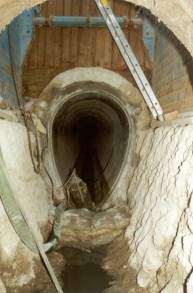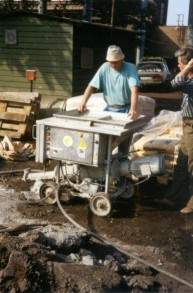Injection
Territory of application
All lining methods, where an unfilled space develops between the pipe to be renovated and the liner and it is necessary for the liner to be settled fix into the old (renovated) pipe.
Description of the injection
It is among the specifications of the sewer reconstruction by the BONEX-method that the space between the existing sewer to be renovated and the liner has to be filled out by a homogeneous, load transmitting material so that it becomes airtight. The cracks, holes and the deteriorated structure of the sewer to be reconstructed can cause settlements upto the surface, which have to be ceased in any case.
All this is provided by injection.
The most simple way of injection in order to fill spaces is to let the material to the space between the liner and the old structure by gravitation. On the other hand it can be applied only if the quantity is small (some m3-s), the space is relatively big (20-25 % of the whole diameter) and the distance is not more than 10-15 m.
In the case of an injection using a machine, the homogeinity and the continuity is provided by the injection of the mortar under pressure.
Sequence of operations:
Pipe inserting one by one
While inserting each pipe will be fixed at the desired place by interrupted walling, by wedging and by creating an adequate relation of fall (MBM-09-BX-06-01).
The injection will be devided up into sections according to the distance between the shafts so that at the wall of the shaft a total, closed walling will be made. The applied material is regularly small brick, but it can also be made of concrete (concrete casting in new shafts).

At the shafts it is necessary to insert also an injection pipe of 2”, which is an angle piece and an other pipe providing ventilation. The pipes have to be put above the highest point of the inserted pipe, into the roof and lead over the walling.
The connections of the main sewer must be closed before the injection so that no injection mortar can get into them.
If the inserted pipes are GRP pipes of DN 80 or more and 58/75 and more they must be sustained by bracing before the injection
At the place of connections higher than 50% of the height of the liner, it is necessary to put a bracing at both sides of the connection.
The bracing eliminates the destructive effects of the pressure developing during the injection which can cause deformation. Thanks to its structure, it can placed easily.
If the injection is made in two steps, the lift force can be reduced; in the case of a pipe with a stifness of 5000 N/m2 there is no need for a strengthening rib.
The course of the injection must be followed from the shaft and if the pipe gets displaced or mortar flows into the pipe, the operation must be stopped till the fault is eliminated.
If mortar appears at the ventilation pipe, the injection must be stopped.
Whether the space is filled, can be controlled by knocking. If we hear a dull sound it leads us to believe that there are some blisters. In this case the injection must be repeated from a new injection pipe.
If we have to inject a section longer than 50 m, we must be prepared for an injection out of the pipe. This must be prepared by inserting an injection cock into the liner. After this the injection must be made – through a cock pushed to the wall of the sewer – till mortar appears at the ventillation pipe.

After having completed the injection, the injection pipe has to be cut at the the shaft wall and has to be grouted with mortar. The inserted strengthening ribs can be removed after 48 hours.
Before the reinstatement of the sewer renewed, the joints and connections must be controlled and if necessary repaired with horpkitt.
In the case of a train-type insertion (MBM-09-BX-06-02) the liner can fixed only at the shafts and the entry shafts as a result of the type of this insertion.
When applying a train-type insertion, the closing down of the house connections has to be made at the beginning of the works. Before the injection, the connection of the laterals can not be made because the main pipe can be moved as a result of the of the injection. In this way the final completion of the connections is possible from the surface, after the hardening of the injection mortar.
The relatively small size and statical diemnsioning of the pipes guarantees that the deformation will be reduced to the extent allowed; the application of an inner strengthening rib is not possible.
The injection can be followed from shaft by watching. It is necessary to ensure the continuity of the injection in the sections between the shafts. This is important because the pipe-train gets to its final place after the whole quantity of mortar is injected, and no inside reparations can be made afterwards.
In the case of a train-type insertion, It is forbidden to stop the injection before the whole space is filled up!
Similar to the technology used in the case of the train-type insertion, injection can be applied also for HDPE and spirally wounded pipes. In the case of both technologies the pipe is fixed at the place of the shafts and open cuts, between the fixing points it floats in the injection material.
Injection from the liner
The following GRP-pipes can be injected by special technologies:
- where the distance between the shafts is big (more than 100 m)
- where the pipes are relined one by one
- it is difficult to reach them from the surface
For the injection the pipes must be bored by a drilling machine at each 12 m length. From the bore at the horizontal axe the first rate of the injection can be made (max. the half of it), from the bore made at the highest point of the vertical axe a following one or two rates can be made.
We have to use injection towers of special design with adjustable height for the second and third rates.
After the hardening of the mortar the bores on the GRP pipes have to be repaired by using glass-fibre veil and a synthetic resin of same quality as the material of the pipe.
Materials to be inserted:
Auxiliary products:
bricks: we can use only solid, hight strength bricks for the walling
mortar: a cement mortar of bigger solidity than the normal, maybe with hardening accelerator (e.i. products like Tricosal S-III.)
injection pipe: a steel pipe of 60 cm length, with an angle piece of 2” (with or without a turn)
Injection material
- cement mortar
- a mortar made by a special plastification material
- mortars of special composition, including light additives

Formula of injection mortar and technical data |
||||||||
By adding water, the compression can be adjusted between 15 and 30 N/mm2 |
||||||||
| Water / cement factor | Begin and end of hardening | Tensile/compressive strength |
Composition of 1m3 | Water / sack of 25 kg |
||||
| Water (liter) |
Blitzdämmer (kg) |
|||||||
| 1 nap | 3 nap | 7 nap | 28 nap | |||||
| 0,45 | 2h50p / 4h50p | 2,2 / 8,2 | 4,5 / 18,0 | 5,4 / 24,0 | 7,0 / 31,0 | 552 | 1226 | 11,25 |
| 0,50 | 3h00p / 5h00p | 2,0 / 7,0 | 4,0 / 16,0 | 5,0 / 19,8 | 6,6 / 28,0 | 576 | 1153 | 12,5 |
| 0,60 | 3h20p / 5h10p | 1,4 / 3,8 | 3,2 / 11,5 | 4,1 / 14,4 | 4,9 / 20,0 | 619 | 1032 | 15,0 |
| 0,70 | 3h30p / 5h15p | 1,0 / 2,5 | 2,3 / 8,2 | 3,5 / 11,2 | 4,1 / 15,4 | 657 | 940 | 17,5 |

